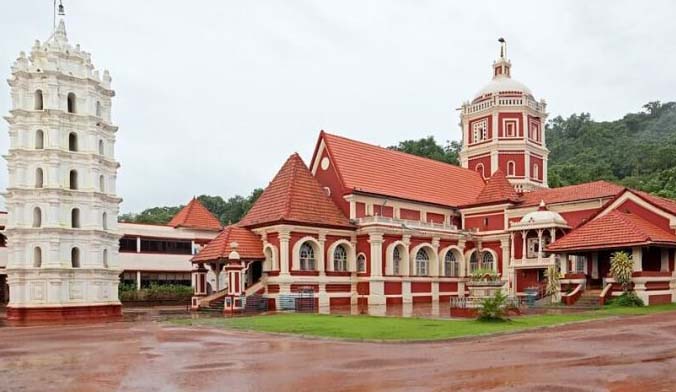Shantadurga Temple

Information of Shantadurga Temple, Kavlem, Ponda, Panjim, Goa
The Shantadurga temple is located in the Northern side of Goa and is one of the largest Hindu temples in the territory. The precise location of the Shantadurga temple is the foothill of Kavlem village in Ponda area of Goa. The temple is beautifies with lush green natural beauty giving the complex a serene and peaceful environment. This temple is dedicated to Shantadurga who manifests between Lord Vishnu and Lord Shiva in order to maintain peace between the two avatars. Locally the Goddess is called as Santeri.
Shantadurga Temple Religious Significance
The Shantadurga temple represents the temple of the most powerful Goddess of Hindu mythology. Shantadurga is another incarnation of the all powerful Divine Mother Parvati. According To Hindu beliefs all Gods and Goddess are one and are just different incarnations and forms. Shantadurga is the Kuldevta of many Saraswat Brahmins of the Konkani area. Shantadurga is also referred to as Jagdamba Devi. The Shantadurga idol is seen with two serpents one on each hand representing Lord Vishnu and Lord Shiva.
The most important festival celebrated in the temple is Durga puja also known as the navraatri festival. The Durga puja ritual is carried out for the whole period of ten days with devotion, belief along with fun and frolic. The temple is open throughout the year for all the Hindus of India.
Shantadurga Temple Mythology & History
The temple along with the deity Shantadurga has very interesting myth associated with them. Goddess Shantadurga as already mentioned mediates between Lord Vishnu and Lord Shiva. Once, the two avatars got into a terrible fight, so, in order to bring peace Lord Brahma prayed to Goddess Parvati to manifest herself as Shantadurga and make peace between them. She held Vishnu on her right hand and Shiva on her left hand and calmed them down and hence settled their battle.
The legend behind the temple says that Shantadurga Devi had gone to Sankwal from Keloshi in Salcette are to kill a demon who was troubling the Brahmins. In order to honour her victory and valour the local people constructed a temple in the name of Vijaya which stands their along with the main shrine of Shantadurga,
Earlier the Devi temple was present in Salsette but due to the Portuguese invasion of 1564 it was demolished like most other temples of Goa. The present temple was constructed in 1730 and completed some years later with the help of Maratha rulers. They built the temple with utmost care and managed to leave with a beautiful simple temple dedicated to Devi.
Shantadurga Temple Architectural Significance
The architectural style of the temple is influenced from Portuguese art blended with Indian art. The temple complex comprises of the main shrine of Shantadurga consisting of pyramidal Shikharas on the entrance hall as well as the main assembly hall. The windows are styled in Roman arches and consist of stained glass designed with yellow, blue, red, green, colours. Its gate post consists of domes and the temple complex is painted with maroon and peach white colours. The post, pillars and floors of the temple are built of Kashmir stone. The temple complex also consists of a sacred tank with holy water, a deepstambha or a lamp tower and guest houses.
There are three other smaller temples surrounding the main shrine dedicated to other Goddesses. A beautiful attraction of the temple is the golden palanquin in which Goddess Shantadurga is carried on special occasions. The idol of the Devi in the sanctum sanctorum is a beautiful piece if golden art decorated with precious ornaments and beautiful flower garlands.
- Andhra Pradesh Temples
- Assam Temples
- Bihar Temples
- New Delhi Temples
- Goa Temples
- Gujarat Temples
- Jammu and Kashmir Temples
- Karnataka Temples
- Kerala Temples
- Madhya Pradesh Temples
- Maharashtra Temples
- Odisha Temples
- Punjab Temples
- Rajasthan Temples
- Sikkim Temples
- Tamil Nadu Temples
- Telangana Temples
- Uttar Pradesh Temples
- Uttarakhand Temples
- West Bengal Temples